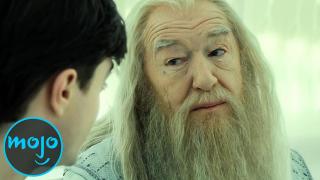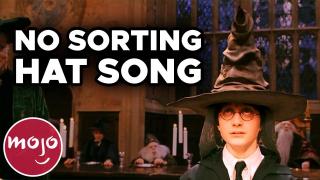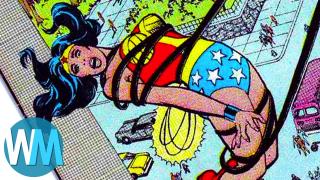Top 10 Times Fantastic Beasts Ignored Harry Potter Lore

#10: Muggles/No-Majs Using Wands
“Fantastic Beasts: The Secrets of Dumbledore” (2022)
The trailers for the third “Fantastic Beasts” film show lovable Muggle, or No-Maj, Jacob Kowalski being given, and seemingly using, a wand. Except he’s not a wizard. The “Harry Potter” franchise has established that wizards and witches don’t always need wands to do magic, but they are used to focus their magic. But Jacob has no magic to focus, so what’s going on here? We’ll grant that the wand itself probably has magic, so maybe it’s exhibiting its fantastical properties on its own, by accident. But if it’s intentional, we’d think it would have to have a witch or wizard holding it, right?
#9: Dumbledore Teaches the Wrong Subject
“Fantastic Beasts: The Crimes of Grindelwald” (2018)
The Origins Of Albus Dumbledore
In flashbacks and during the events of “Fantastic Beasts,” Albus Dumbledore is depicted teaching Defense Against the Dark Arts. It’s fitting, given how powerful a wizard he is, both then and in the future. Yet in the “Harry Potter” books, it’s established that Dumbledore was the Transfiguration teacher, at least when Tom Riddle, the would-be Voldemort, was attending Hogwarts. Granted, it’s possible he switched subjects – he’s a man of many talents. Still, it’s a little weird that the books cite a different Defense Against the Dark Arts teacher who’s been at Hogwarts for 50 years and who wrote multiple books on the subject.
#8: The Whomping Willow Shouldn’t Exist Yet
“Fantastic Beasts: The Crimes of Grindelwald” (2018)
Harry Potter Week Is HERE! Vote on Your Favorite Harry Potter Movie!
The second “Fantastic Beasts” film takes a trip back to Hogwarts, both during the events of the story and in flashbacks. During the latter, one of the familiar landmarks shown is the Whomping Willow, the semi-mobile, hostile tree on the grounds of the school. But fans of the books know that the tree was only planted due to Remus Lupin attending the school. So why would the staff at Hogwarts need to hide a secret passage to a werewolf student’s hideout decades before said werewolf was even born? Granted, it could be a different tree, but that seems like a strange coincidence.
#7: What Dumbledore Sees in the Mirror of Erised
“Fantastic Beasts: The Crimes of Grindelwald” (2018)
Top 10 Differences Between Harry Potter and the Philosopher's Stone Movie & Book
The Mirror of Erised is a magical object we’re introduced to in the first “Harry Potter” film. By looking into it, the viewer sees whatever it is they desire most in the world. Now, J.K. Rowling reportedly once said that Dumbledore’s greatest wish is for his shattered and departed family to be alive and happy together. Contradicting this, “The Crimes of Grindelwald,” shows Dumbledore seeing Grindelwald himself, not-so-subtly implying their intimate relationship together. Granted, it’s established that what appears to you in the mirror can change. And yes, Dumbledore’s feelings for Grindelwald certainly add some credibility to the moment. But it still feels odd that instead of seeing his dead sister, he sees the former “friend” who may have caused her death.
#6: The Blood Pact
“Fantastic Beasts: The Crimes of Grindelwald” (2018)
Top 10 Fantastic Harry Potter Creatures
A big part of “The Crimes of Grindelwald” is the retrieval of the “Blood Pact” that Dumbledore made with Grindelwald. Indeed, the duo enacted a magical promise not to fight each other way back in the day. And we get it, this makes Dumbledore look like a better person for not getting involved in the fight against the evil wizard. Unfortunately, it doesn’t make a whole lot of sense! The two of them originally fell out after having a three way duel with Dumbledore’s brother, which resulted in their sister Ariana’s death. So how can Dumbledore and Grindelwald have made a blood pact not to fight each other and then…have fought each other?
#5: Apparating in Hogwarts Grounds
“Fantastic Beasts: The Crimes of Grindelwald” (2018)
Apparating is the wizard world’s equivalent to a teleportation spell. Throughout the franchise, the specifics of how it works and what it looks like tend to vary. But there’s one hard and fast rule that the books have beaten into fans’ heads – you CANNOT Apparate into or out of the Hogwarts grounds! It’s even a major plot point, as Draco Malfoy has to find a different way to get Death Eaters onto the land in the sixth installment. Sure, Dumbledore can do it, but he’s the Headmaster! Yet in “The Crimes of Grindelwald,” we see Ministry officials Apparate unannounced onto the grounds to see Dumbledore. Where’s the consistency in this magical world?
#4: Professor McGonagall Appears Too Soon
“Fantastic Beasts: The Crimes of Grindelwald” (2018)
Professor Marston and the Wonder Women Review! Top 5 Surprising Takeaways
Professor Minerva McGonagall is one of Hogwarts’ most iconic teachers, a fixture of the institution. And “The Crimes of Grindelwald” shows her as a contemporary of Dumbledore in both its present timeline, set in 1927, and a flashback, set around 1910. Except, in the books, McGonagall tells Umbridge that she’s been teaching at Hogwarts for almost 40 years. That’s a great deal less than it would be if she were the person who appears in the film. Okay, so maybe it’s a relative of hers from her father’s side of the family? Her Muggle father’s side of the family? Or maybe Hogwarts has had multiple Scottish professors named McGonagall…or maybe it’s just bad writing.
#3: The Last Lestrange?
“Fantastic Beasts: The Crimes of Grindelwald” (2018)
Top 10 Fantastic Beasts and Where to Find Them Facts
A huge plot thread running through “The Crimes of Grindelwald” involves the possibility that Credence Barebone is secretly a member of the Lestrange family. That apparently ends up not being the case, but more on that soon. The rumors about Credence being a Lestrange also relate to him being the last male member of the family line. It turns out that Corvus, the real child in question, is long dead. And by the film’s end, so too is Leta Lestrange. So if they’ve all passed away, where does Rodolphus — who goes on to marry Bellatrix, giving her the Lestrange name — come from? Perhaps a different branch of the family tree is involved? Because as far as we know, ghosts don’t reproduce!
#2: Credence Barebone’s Lineage
“Fantastic Beasts: The Crimes of Grindelwald” (2018)
The big reveal at the end of “The Crimes of Grindelwald” is that Credence Barebone is from a famous family after all – the Dumbledores. Well that’s the story Grindelwald tells, anyway. We still have our doubts as to whether he’s really “Aurelius Dumbledore”. That’s right, Grindelwald alludes to Albus Dumbledore being Credence’s brother. But Albus’ father, Percival, was in Azkaban years before Credence was even born! We’re pretty sure they don’t allow conjugal visits there. And even if they did, Percival was likely already dead! Either the franchise is going to pull out some kind of wacky magical explanation, or Grindelwald is simply lying to manipulate Credence.
Before we get to our top pick, here are a few honorable mentions:
Accio Animals, “Fantastic Beasts: The Crimes of Grindelwald” (2018)
The Summoning Spell Is Supposed to Work on Objects, Not Living Beings
Grindelwald’s Accent, “Fantastic Beasts: The Crimes of Grindelwald” (2018)
While His Exact Country of Origin Is Unknown, He’s Likely Not English
Dumbledore’s Robes, “Fantastic Beasts: The Crimes of Grindelwald” (2018)
Not That He Isn’t Dapper, but His Mystique Lies in the Fact That He’s the Classical Wizard Archetype
#1: The Elder Wand’s Mastery
“Fantastic Beasts” franchise (2016-)
Top 10 Harry Potter Fan Theories We Want to Be True
The final two “Harry Potter” films deal heavily with the Deathly Hallows, near-mythical magical objects which include the incredibly powerful Elder Wand. To make a long story short, whoever defeats or disarms its current user becomes its “master.” While the previous owner can still use it, the Elder Wand won’t work at full power with them. During the first “Fantastic Beasts” film, Grindelwald is the object’s master. However, he’s defeated and disarmed by Tina and Newt at the end. While he isn’t using the Elder Wand at that moment, Grindelwald still should have lost ownership to one of them. Yet in the second film, he uses it just fine, with no apparent issues. It seems Rowling isn’t quite the master of her own lore.








